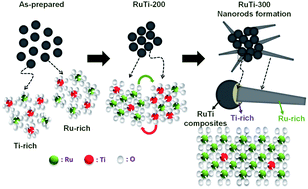Thermal-induced growth of RuO2nanorods from a binary Ru–Ti oxide composite and alteration in supercapacitive characteristics†
Abstract
The growth of crystalline RuO2

* Corresponding authors
a
Department of Chemical Engineering, National Tsing Hua University, Hsin-Chu 30013, Taiwan
E-mail:
cchu@che.nthu.edu.tw
Fax: +886-3-5736027
Tel: +886-3-5736027
b Department of Engineering and System Science, National Tsing Hua University, Hsin-Chu 30013, Taiwan
The growth of crystalline RuO2

 Please wait while we load your content...
Something went wrong. Try again?
Please wait while we load your content...
Something went wrong. Try again?
I. Chen, T. Chen, C. Hu and C. Lee, J. Mater. Chem. A, 2013, 1, 2039 DOI: 10.1039/C2TA01111E
To request permission to reproduce material from this article, please go to the Copyright Clearance Center request page.
If you are an author contributing to an RSC publication, you do not need to request permission provided correct acknowledgement is given.
If you are the author of this article, you do not need to request permission to reproduce figures and diagrams provided correct acknowledgement is given. If you want to reproduce the whole article in a third-party publication (excluding your thesis/dissertation for which permission is not required) please go to the Copyright Clearance Center request page.
Read more about how to correctly acknowledge RSC content.
 Fetching data from CrossRef.
Fetching data from CrossRef.
This may take some time to load.
Loading related content
